The ARM vs x86 Wars Have Begun: In-Depth Power Analysis of Atom, Krait & Cortex A15
by Anand Lal Shimpi on January 4, 2013 7:32 AM EST- Posted in
- Tablets
- Intel
- Samsung
- Arm
- Cortex A15
- Smartphones
- Mobile
- SoCs
Krait: Idle Power
We'll start out our power investigation looking at behavior at idle. Although battery life when you're actually using your device is very important, having a fast SoC that can quickly complete tasks and race to sleep means that you need to be able to drive down to very low idle power levels to actually benefit from that performance. Here we're looking at power consumption at the Start Screen in Windows RT/8. You'll notice that there are two distinct periods during the benchmark, with the latter part of the graph showing lower power consumption thanks to the live tiles going to sleep. In this test, WiFi is enabled but there's no background syncing of anything. WiFi being on is why we continue to see power spikes even after the live tiles have gone to sleep:
The W510 does a great job of drawing little power at idle. Its silly WiFi implementation results in peak idle power consumption that's very similar to the Dell XPS 10, but the lowest the platform hits is appreciably lower than anything else. Surface RT remains the more power hungry of the three, while the XPS 10 falls somewhere in between MS and Acer.
If we isolate CPU core power alone though, things are a bit different. Keep in mind that we don't have the L2 power island instrumented, so the XPS 10 looks a little better than it should here but minimum CPU power consumption is very good on Krait. Although the Atom Z2760 is built on a special SoC derivative of Intel's 32nm process, I do suspect that it's not quite as low power as TSMC's 28nm LP. Things may change by the time 22nm rolls around however. All meaningful compute transistors here should be power gated, and what we end up looking at is the best case leakage for all SoCs. The Krait/28nm LP combination is awesome. I'm not sure why Tegra 3 is so much more active here towards the very end of the curve by comparison.
Adreno 225, or at least whatever Qualcomm drives off of the GPU power rail is extremely power efficient at idle. The PowerVR SGX 545 curve looks flatter at the end but Qualcomm is able to hit lower minimum power levels. It's not clear to me how much of this is architecture vs. process technology. On the GPU side there is some activity happening here as the display is still being refreshed even though the system is idle, so we're not looking at purely power gated consumption here.
To take the WiFi controller out of the equation, I tossed all tablets into Airplane mode and re-ran the same tests as above. You'll notice much less fluctuation in power consumption once the live tiles go to sleep.
Take WiFi out of the equation and Acer's W510 looks really good. Intel worked very hard with Acer to ensure power consumption was as low as possible on this device. The XPS 10 does a bit better than Surface RT here, but not tremendously so. Acer/Intel hold the clear advantage.
Looking at the CPU power island alone (excluding the L2 cache for Krait), we continue to see lower idle power consumption from APQ8060A vs. Atom Z2760. Once again I believe this is a TSMC 28nm LP advantage more than an architectural thing.


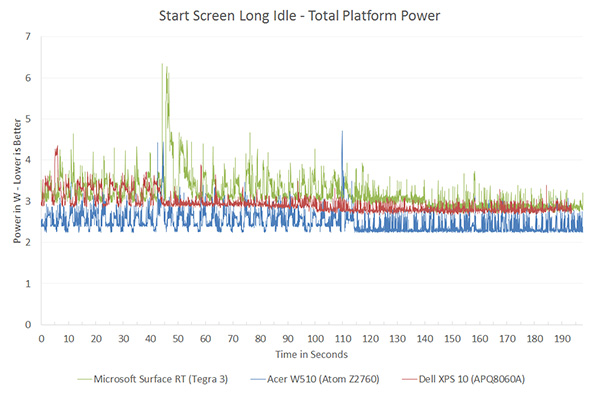
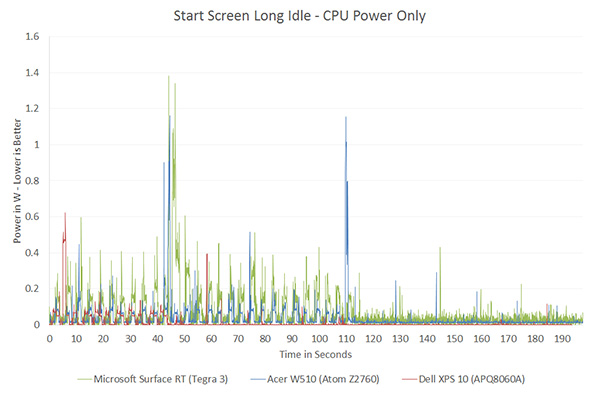
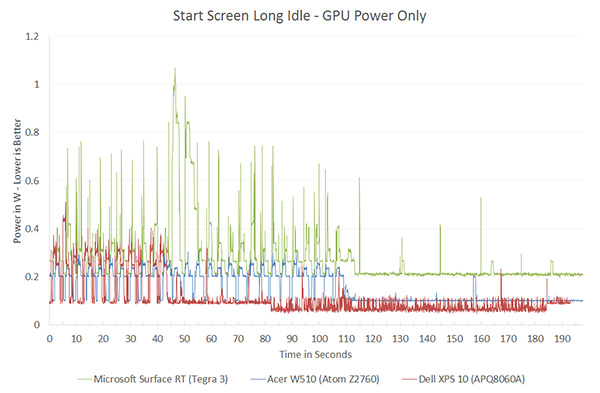
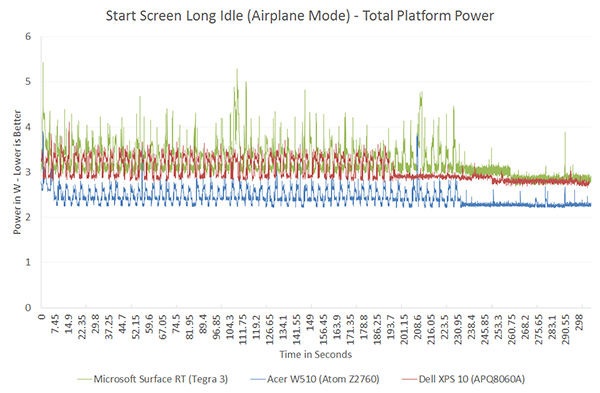
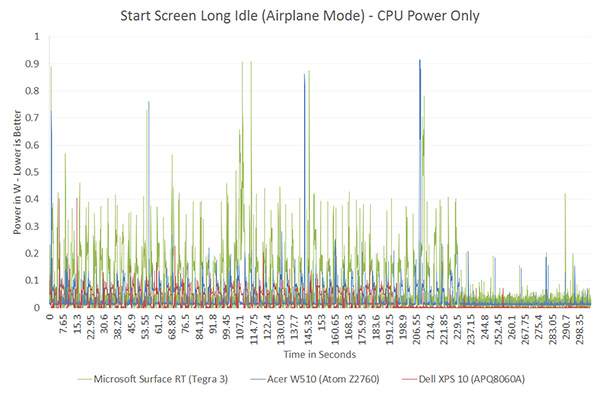
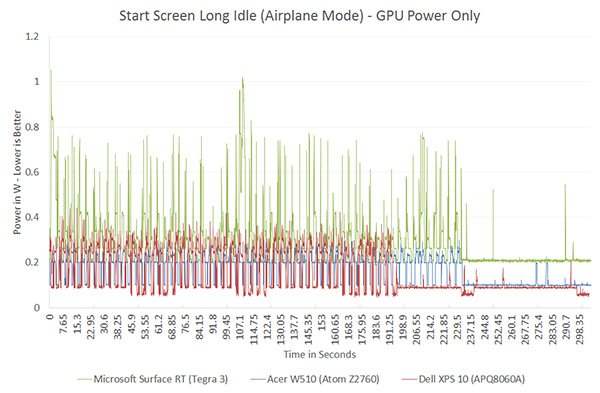








140 Comments
View All Comments
powerarmour - Friday, January 4, 2013 - link
"Intel doesn't want to create a chip that cuts into it's very profitable mainstream CPU market."Indeed, they've left Cedar Trail to fester and die by totally withdrawing driver support :-
http://communities.intel.com/message/175069#175069
Quite a lot of desktop Atom hardware is still on the market, and they are trying their best to kill it off.
djgandy - Friday, January 4, 2013 - link
All that says to me is that they don't care about Win7 i.e. non tablets.Krysto - Friday, January 4, 2013 - link
Cortex A15 coupled with Cortex A7 will use half the power on average. Also, I told you before that Mali T604 is more efficient than PowerVR in the latest iPads, and that's why Apple managed to use a more powerful GPU - because it's more inefficient. They sacrificed energy efficiency for performance, because they can use a very large battery in the iPad.I saw you're trying hard to "prove something" about Intel lately, and I'm not sure why. Is Intel is biggest "client" when they pay you for reviews here? Is that why you're trying so hard to make them look good?
You're also always making unebelivable claims about what Intel chips will do in the future. Even if they get Haswell to 8W (is that for CPU only? The whole SoC? Is it peak TDP? Will it still need fans?), you do realize a Haswell chip costs as much as the whole BOM of an iPhone 5 right? Haswell chips will never arrive in smartphones, or in tablets that are competitive on price.
Tetracycloide - Friday, January 4, 2013 - link
You're always making "unebelivable" claims about what corruption does here. Do you have anything to back up your allegations to a normal person who would view any excitement about future possibilities as some kind of damning evidence that the writer must be on the take? It's like you think everyone that doesn't share your opinion of Intel is paid to have that opinion or something.trivik12 - Friday, January 4, 2013 - link
Haswell ULV is a SOC. So the platform TDP was < 8W. You like it or lot intel has the best process technology and ultimately they will produce a platform which is faster and lower TDP.That being said ARM will dominate the smartphone market and even majority of low end laptops. I see intel existing only in mid to higher end smartphone plus tablets > $500.
I am personally waiting for broadwell based tablet which should hopefully cut power even more in 14nm process.
djgandy - Friday, January 4, 2013 - link
You'd hope two brand new technologies would be better than two 3/4 year old ones wouldn't you. Clearly you are blinded by your love for ARM in the same way many here are blinded by love for Nvidia and actually consider Tegra 3 a competitive SOC.I don't think many people would be astonished to find that the T604, an architecture only released a few months back, is more efficient than PowerVR Series 5, dating back to 2008.
Why are people so shocked to find that Intel can make a low power chip? It's not some kind of magic, it is a business goal. Power is a trade off just like performance. When you have desktop systems the trade off for using more power is seen as a pro for a 40-50% performance gain.
mrdude - Friday, January 4, 2013 - link
He's spot on about the pricing issue, though. Intel isn't going to start selling Haswell SoCs for $30, and if they do then they'll quickly go out of business. It's a completely different business model that they're trying to compete with. The Tegra 3 costs $15-$25 (and way closer to that $15 to date) while Intel charges $70+ for their CPU+GPU, and that's before you get to the chipset, WiFi and the rest. A low-TDP Haswell chip might offer great performance and fit in the same form factor (tablets), but if the tablet ends up costing $800+ and isn't Apple, well... nobody cares.It's not just a matter of performance but performance-per-dollar and design wins. Intel can't afford to drop prices to competitive levels on their Core products unless they can supplement it with very high volume. For very high volume you need to sell a lot of competitive SoCs that can do it all at a very reasonable price. The Tegra 3 was a big success not because it was an amazing performer, but because it offered decent performance for a very low price tag. Can Intel afford to do that with their cash cow business slipping? Remember that x86 seeing drops in sales and PCs aren't exactly doing very well right now. Intel already had to drop their margins and they've let fabs run idle and sent home engineers at their 14nm fab in Ireland all the while processor prices haven't decreased even a tiny bit. Those aren't signs of a company that's willing to compete on price
Homeles - Friday, January 4, 2013 - link
I'm more than willing to pay for the performance premium.mrdude - Friday, January 4, 2013 - link
While you may be willing to fork over that much cash, most people won't. If you don't believe me, check out the recent sales figures of Win8 devices. The Win8 tablets (excluding Surface RT) don't even make up 1% of all Win8 products sold. That's not poor, that's absolutely horrible. On the other side the cheap Android tablets and smartphones have been gaining significant market share and outselling even the iPhone and iPads. Price matters. A lot. Furthermore, device makers/OEMs are more likely to go with the cheaper SoC if the experience is roughly equal. Remember that a majority of tablet and smartphone buyers don't browse Anandtech for benchmarks but buy based on things like display quality or whether it's got a nice look (or brand name, in the case of Apple). If an OEM can take that $60 saved and put it towards a better display, a larger battery or more NAND then that means a lot more in differentiating yourself from the competition than being 10-15% faster in X benchmark.People forget that these are SoCs and not CPUs. They also forget that these aren't DIY computers but tablets. Think about how much people complain when they see a $900 Ultrabook with a crappy 1366x768 TN display but those same people don't utter a word about how Intel's ULVs cost the same as their 35W parts. If the Intel chip was cheaper you'd probably have a better display or a cheaper price tag. This same notion extends to tablets and smartphones.
Qualcomm is in a place where they can offer something everybody wants; their LTE is second to none. What does Intel have to offer to warrant Intel prices? Currently Intel's chipsets cost as much as an entire Tegra 3 SoC. x86 PC/server and ARM SoCs are in a completely different universe when it comes to pricing, and unless you've got something special (see Qualcomm or Apple) or you're making and selling the device (Samsung), then you're going to have a very rough time of it.
jeffkro - Saturday, January 5, 2013 - link
I paid $15 to "upgrade" my laptop and have since gone back to win 7. A lot of people simply don't want win 8 at any cost.